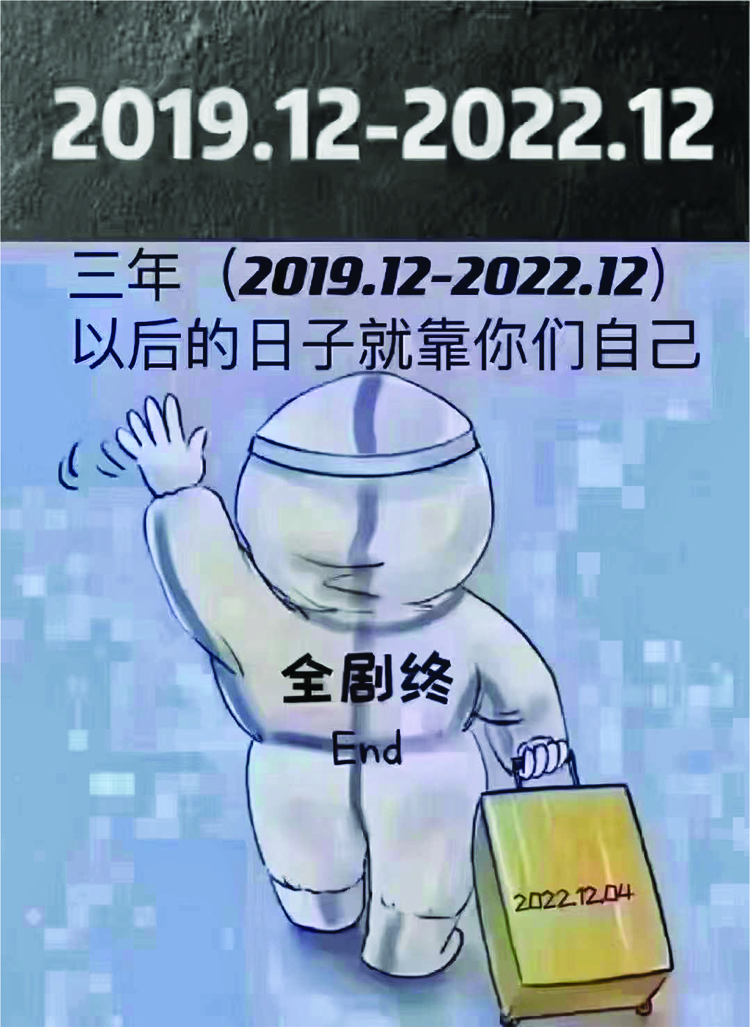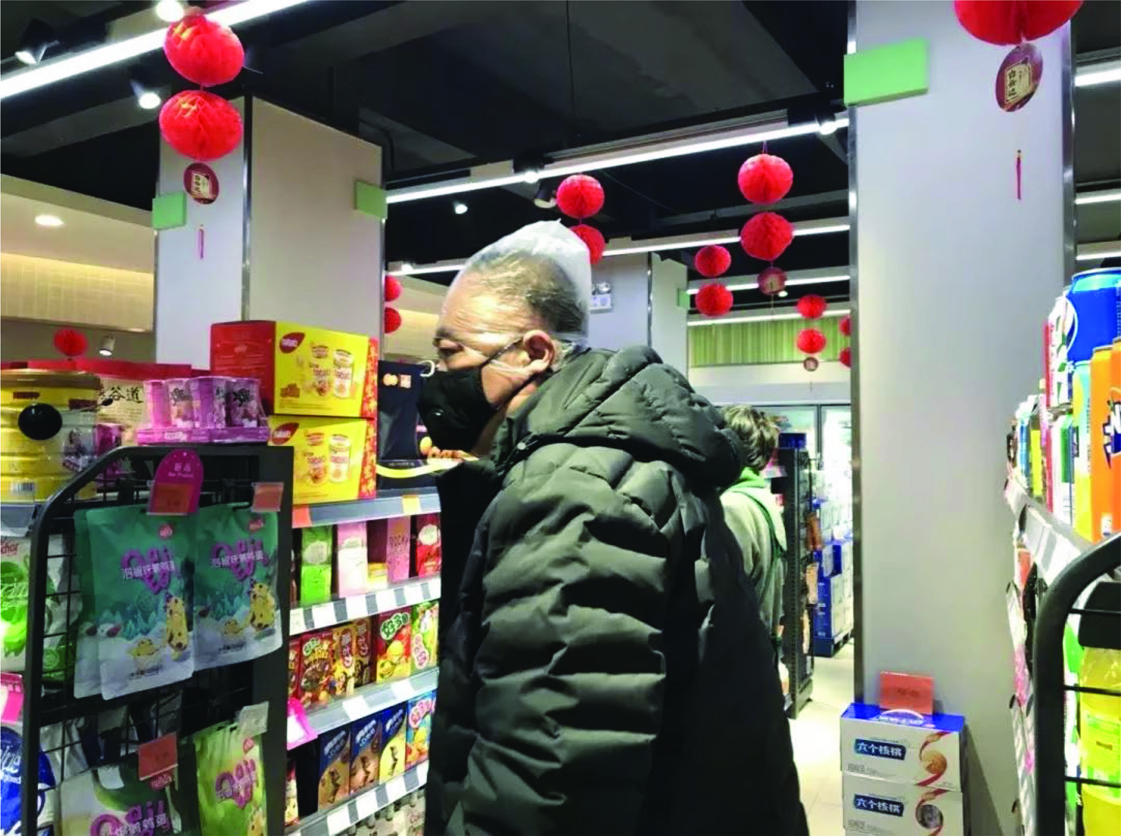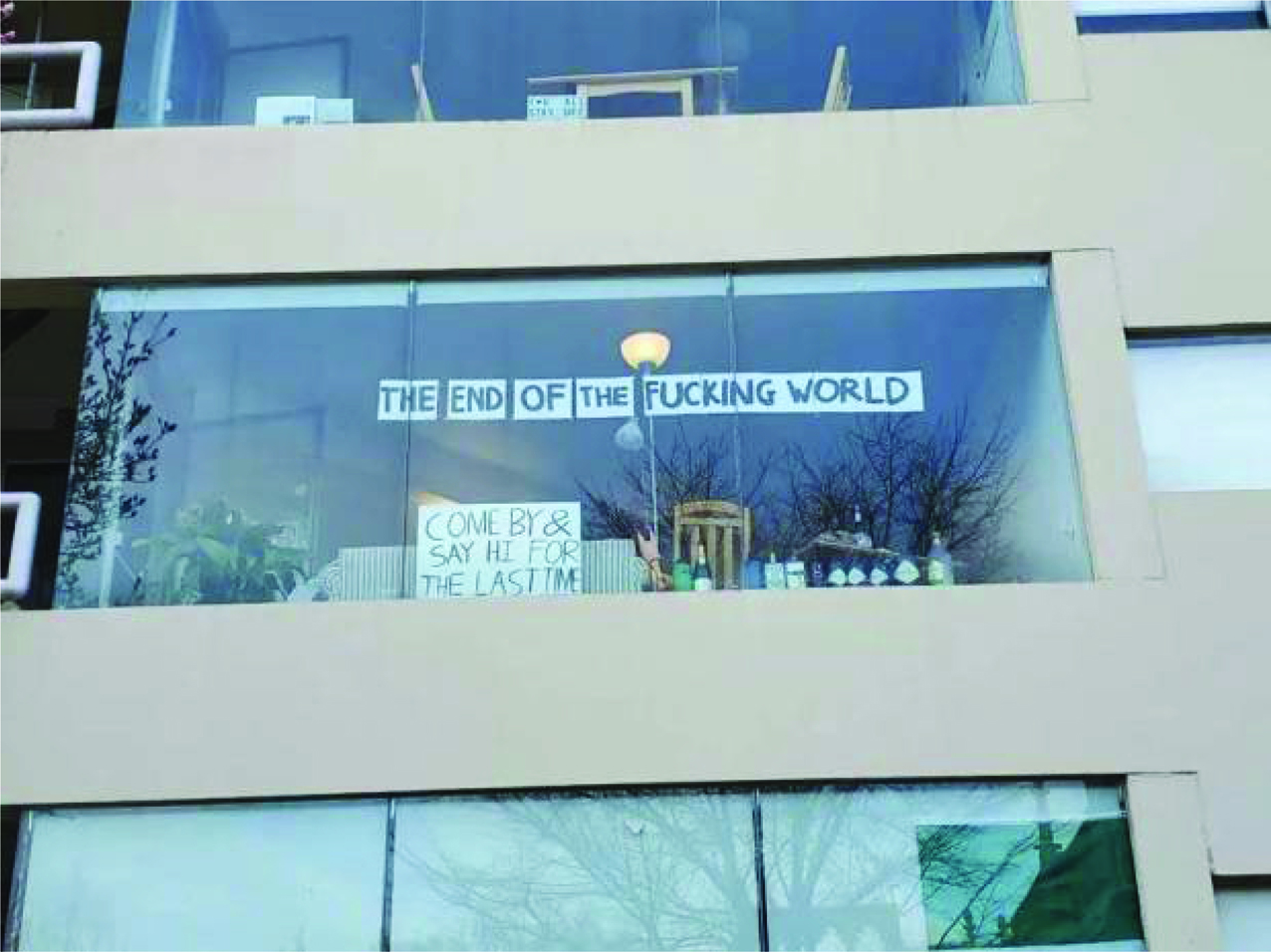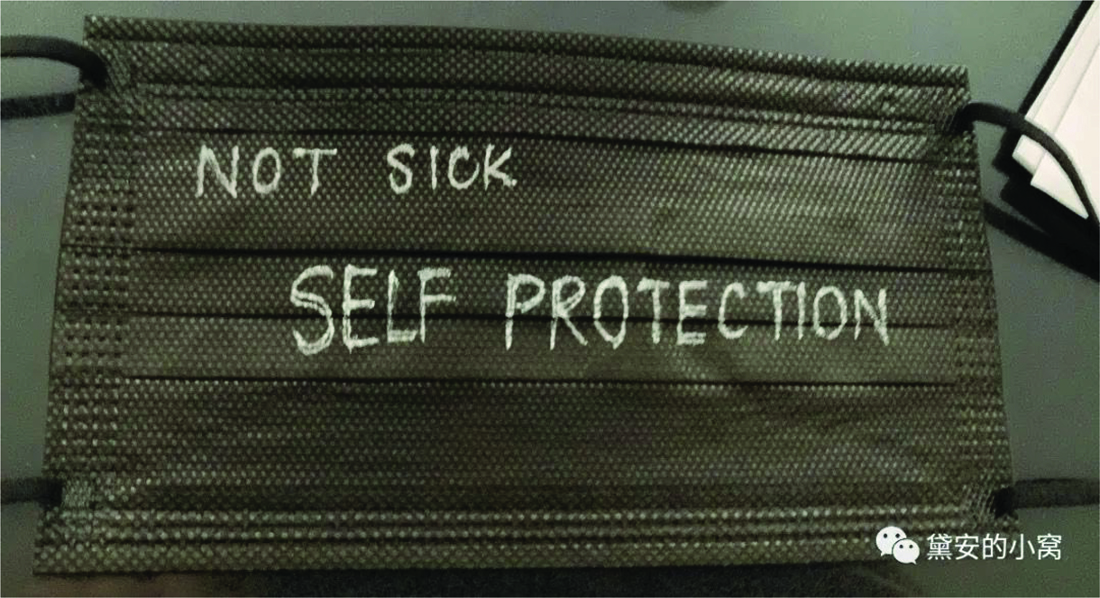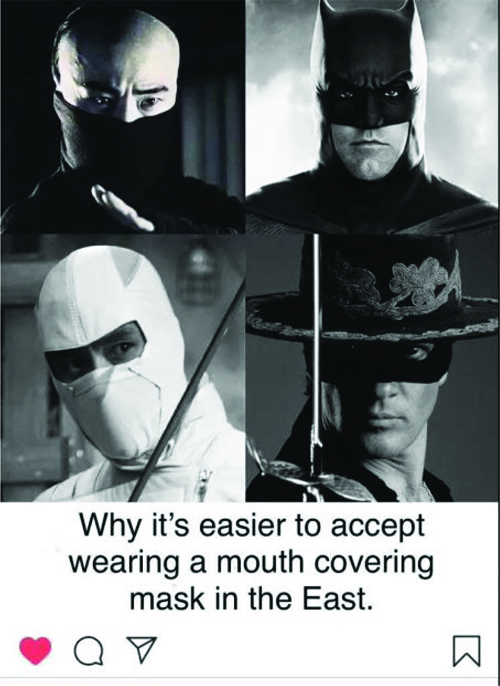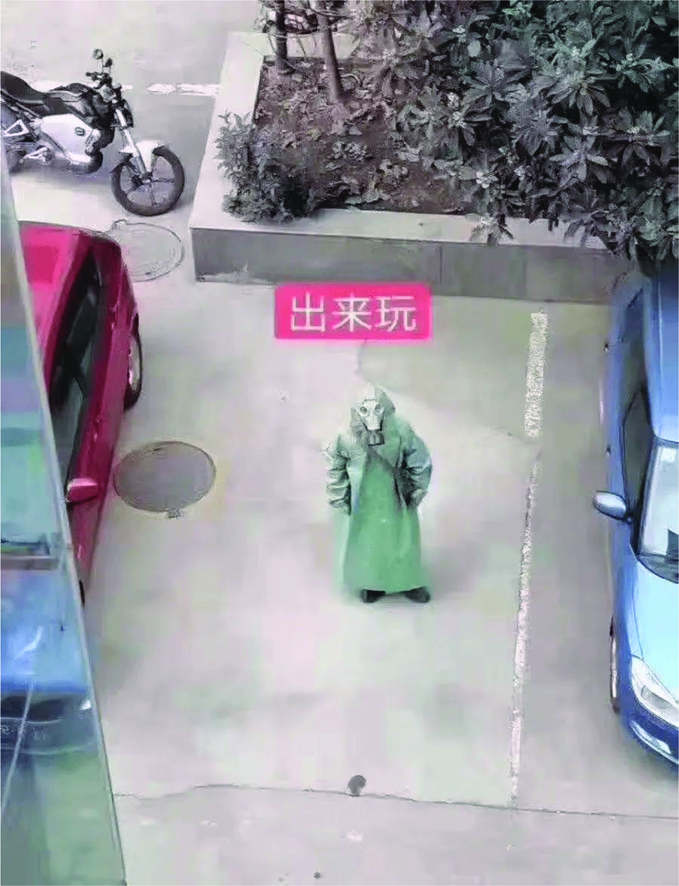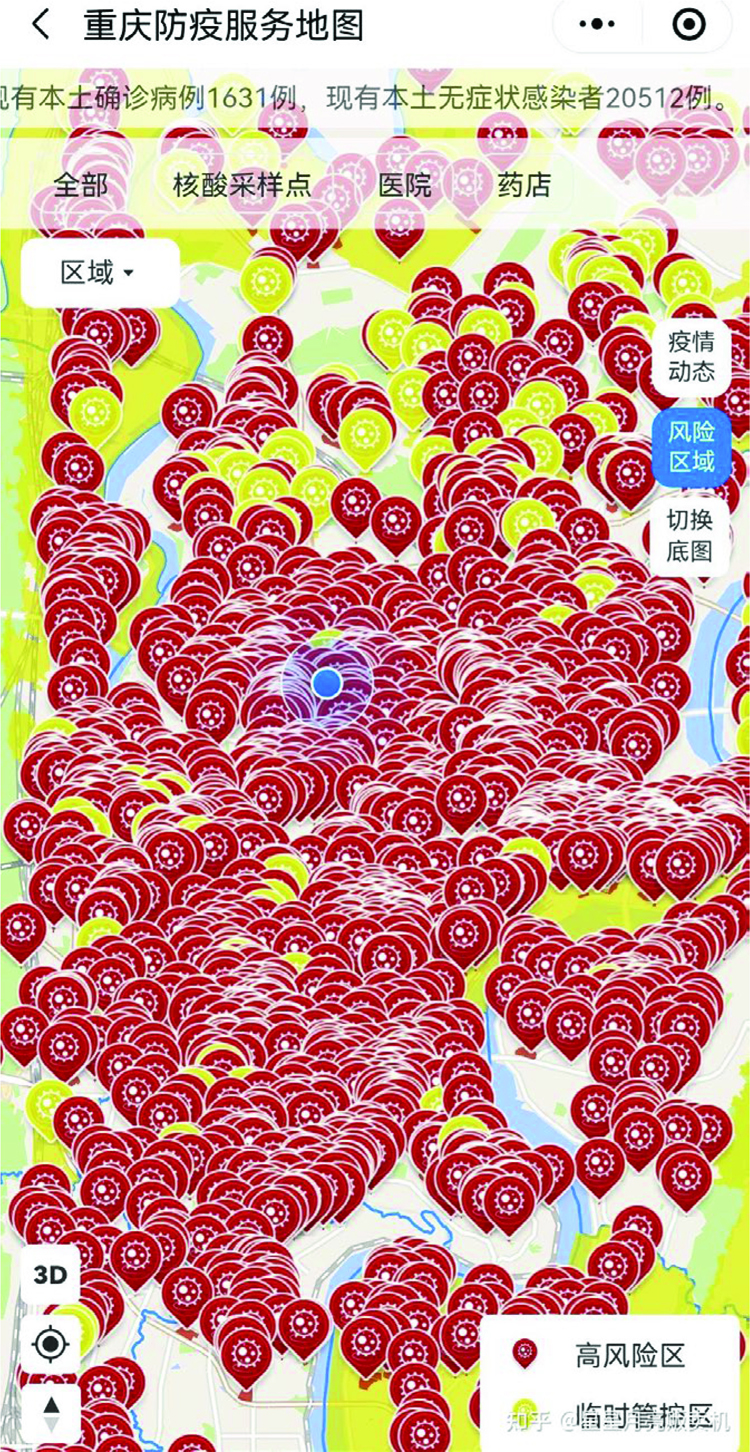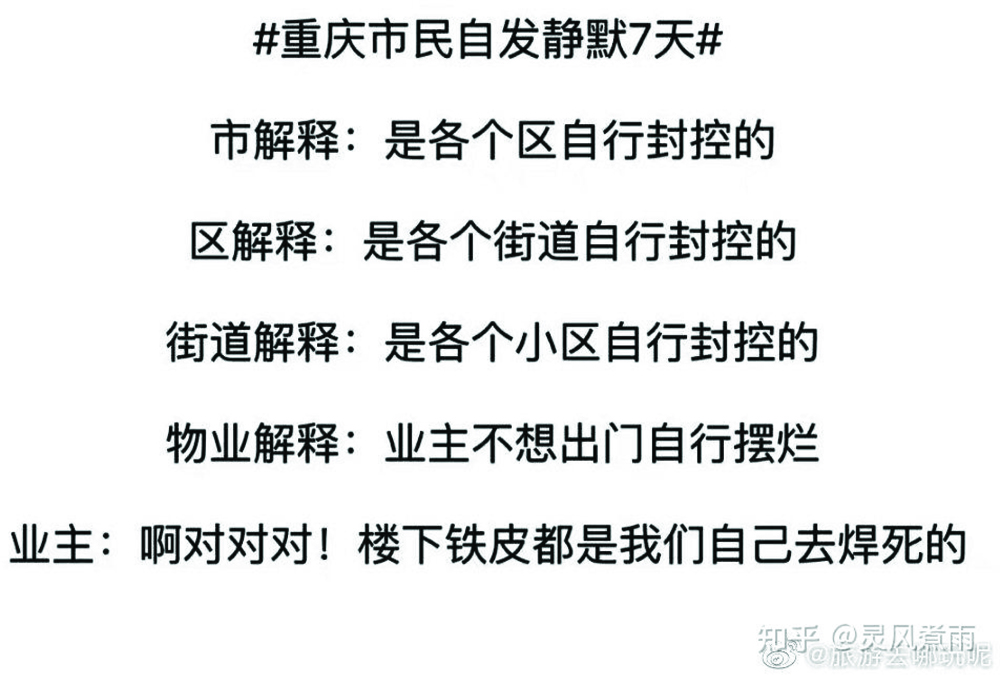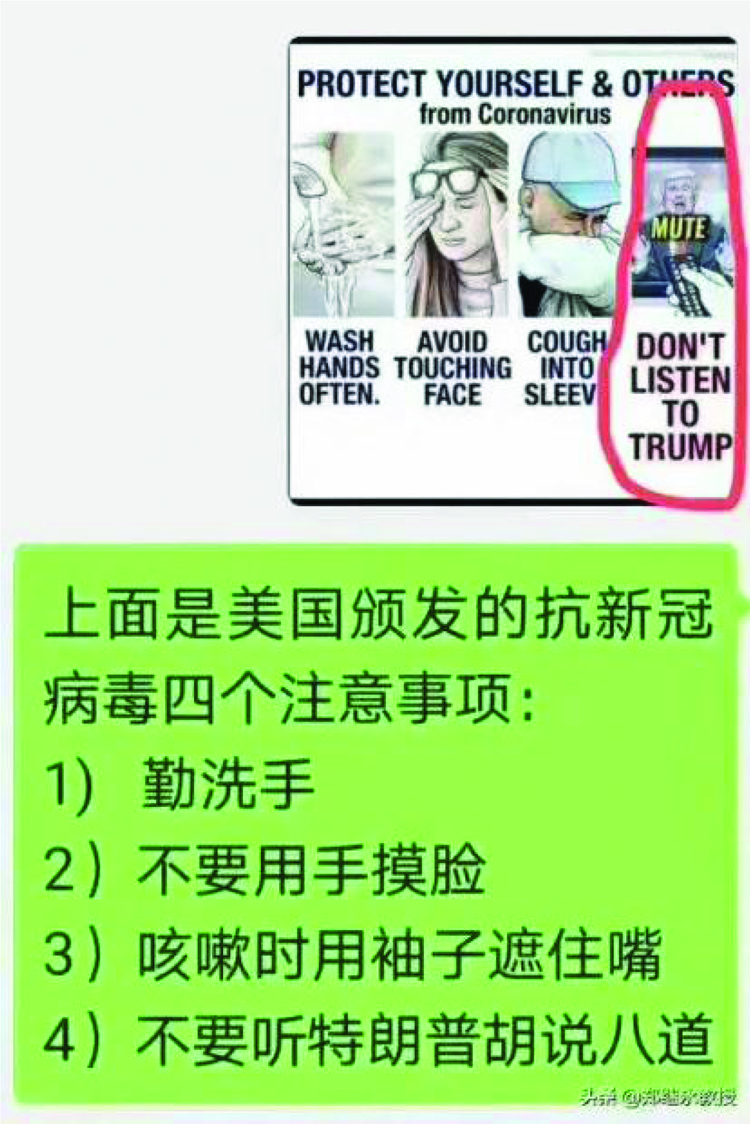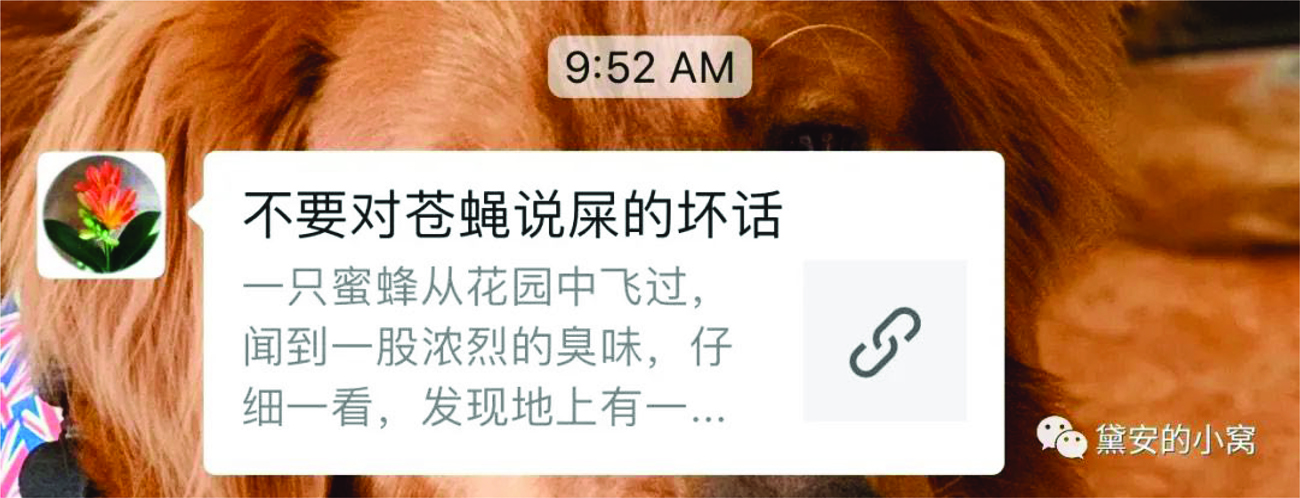Laughter is irrefutable. The only adequate response to laughter is: laughter!
—Anton C. Zijderveld
Introduction
On December 4, 2022, China’s National Health Commission announced an end to the strictest rules of its zero-COVID policy in response to nationwide protests after a deadly fire at a locked-down residence in Ürümqi 烏魯木齊, Xinjiang 新疆, in late November.1 A cartoon was widely circulated on Tencent’s (Tengxun 騰訊) super app WeChat (Weixin 微信, “micro-message”), celebrating the abrupt endgame of the three-year show of the “big white” (da bai 大白), a nickname borrowed from the health-care robot Baymax in Disney’s 2014 animated movie Big Hero 6 for Chinese COVID workers in PPE: “Three years, on your own from now on” (see figure 1).2
This is just one of a multitude of literary genres and media forms that indicate common discontent in China. Online diaries, jokes, webtoons, short videos, memes, deepfakes, and the recent “mad literature” (fafeng wenxue 發瘋文學) have all used humor and satire as safe entries into and exits from communist censorship.3 People complained that three years had been wasted in quarantine camps, sealed buildings, city lockdowns, closed borders, mobility restrictions, contact tracing, digital surveillance, and PCR tests instead of medical preparations such as mRNA vaccination and ICU and hospital expansions. While a few funny digital artworks were misleading about COVID-19 vaccines or functioned as patriotic political propaganda, the digital public took pleasure in lightheartedness and biting humor to subvert authority by mocking the policymakers through the hyper-connections of liking, sharing, and commenting on their mobile phones at a time of depression and anxiety.4 With everyday entries, epidemic journals serve to alleviate daily stress in the face of absurd sociopolitical realities.
The literary genre is defined by literary scholars Batsheva Ben-Amos and Dan Ben-Amos in their introduction to The Diary: The Epic of Everyday Life: “Diary writing records time as a human experience; an entry’s length and brevity depend on emotions, not nature, fusing past memories with future expectations.”5 These emotions of memories and expectations should include not only grief and sorrow but also laughter and humor in hard times. Psychologist C. George Boeree found in emotions the “ ‘tone of existence’ and the very carrier of consciousness itself,” thus explaining “humor” as “the sudden awareness of an alternative construction of a distressful situation which dissipates (to some extent) that distress”; and the “alternative construction,” achieved by violation of social orders, generates a sense of safety in stressful situations: “Humor is the discovery of safety within fear, just like laughter, humor’s physical counterpoint, is relaxation within stress.”6 In effect, laughter, defined by the Dutch sociologist Anton C. Zijderveld as “the language of humor,” is an existential and conscious expression for people to deal with the disturbing situation of the coronavirus.7 It has become an essential element in the everyday epic of the epidemic.
This article discusses verbal and visual jokes selected from eleven online diaries posted on six Chinese social media platforms—namely, Caixin 財新 news, the Matters website, Meiri toutiao 每日頭條 daily headlines, Sina Weibo 新浪微博 microblogging, WeChat instant messaging, and the Zhihu 知乎 forum. Written by women, these diaries are consistent with the female-led public criticism of COVID policies, as represented by the young White Paper Revolution (bai zhi geming 白紙革命) organizer Li Kangmeng 李康夢 and her female peers in Shanghai on November 24, 2022.8 Compared to the works of male writers, these Chinese women’s diaries tend to be less technical and more concerned about individual suffering. There are historical precedents to these gendered pandemic writings in China, such as Chi Zijian’s 遲子健 2010 novel Snow and Raven (Baixue wuya 白雪烏鴉), which is about the Manchurian Plague of 1910–11, but it is largely literary imagination.
The eleven online diaries are chosen among the mass data available on the Internet from 2020 to early 2023 and categorized thematically. They function as moments of telling truths against the official grand narratives and awakening those who are asleep such as those in Lu Xun’s 魯迅 “iron house.”9 Such tragicomic moments are communicated across social platforms by Chinese living around the world and are representative of a much larger body and variety of online diaries, which are created, translated, copied, and circulated among unknown numbers of global netizens. Sociologist Yang Guobin 楊國斌 has surveyed forty-six online lockdown diaries in Wuhan and found more women diarists than men.10 As important as the gender perspective is, this article focuses on the women diarists’ use of visual and verbal humor and offers a “surface reading” of the COVID image-texts embedded in the diaries. “Surface reading” refuses the conventional practice of “close reading” or “symptomatic reading” that strives to dig out the deep psychoanalysis and political meanings hidden in the writing; instead, it is “a practice of critical description” that looks for “what is evident, perceptible, apprehensible in texts” by “attending to the text, or to one’s affective responses to it”—in short, it “lets ghosts be ghosts.”11 These literary and visual surfaces bear witness to the complex truths always already laid bare.
With regard to recent humor studies concerning China, Zhu Ping 朱萍 has provided a historical context of laughter in socialist China, pointing out that “the art of laughter was carefully moderated and regulated for political ends,” particularly “proletarian revolutionary optimism” during the Mao period.12 Furthermore, in his groundbreaking research on online literature, Michel Hockx studies the nature of the Internet that lends force to the dissemination of digital writing in post-socialist China since the 1990s, yet he mainly focuses on online fiction and poetry, giving only one emerging example of web-based diaries about diseases—that is, an AIDS sufferer’s decade-long diary-style chronicle dated between 2001 and 2010.13 This article seeks to fill the scholarly gaps by looking at the important and interesting role played by technology in forming new diary communities across classes and countries in critiques of both communist and capitalist controls of COVID-19.
Meanwhile, literary and cultural historian Christopher Rea sees laughter as “a broad spectrum of attitudes and behaviors ranging from amusement to buffoonery to derision.”14 Humor and satire are the two major forms of laughter found in the selected diaries. Humor is relatively gentle, providing lighthearted relief for negative emotions, while satire typically contains biting social commentaries that are subversive. Thus, this article is divided into two main sections based on the kinds of laughter that one can derive from the selected diaries: a review of humor for daily health and an analysis of satire for sociopolitical subversion.
Humor for Daily Health
Humor is healthy, and humor about health during the plague is particularly important to sustain everyday life. On the one hand, according to the relief theory, it functions as a channel to release physiological tensions; on the other, based on the incongruity theory, it is a cognitive shift between different rational patterns.15 Zijderveld speculates about “humor’s most important function: it often works as a de-ideologizing and disillusioning force”16—especially during the epidemic when the authority brainwashes people into conformity and subservience. In the face of fear and death, humor can be a catharsis to release and dissolve ideology and illusion.
For our first example, feminist activist and social worker Guo Jing 郭晶 frequently employed humor in her diary to capture the absurdity of everyday life in a lockdown city. In one entry, she wrote, “Someone complained that they lost their appetite lately, later they discovered that their appetite is perfectly fine, the problem is just that the food they made at home was thoroughly unappetizing.”17 In another entry, Guo wrote about the sense of powerlessness and the need for environmental protection during the pandemic. The diarist shared a photograph of a supermarket customer covering his head with an extra plastic bag on top of his face mask (see figure 2).18 With small red lanterns and shelfful of grocery items around, the picture is colorful, conveying a happy mood of the Lunar New Year, yet the aged man contemplating at the center wears black, darkening the overall mood. The incongruity of the transparent plastic bag on his head adds a note of absurdity and makes the composition funny.
Source: Guo Jing, “Yu wuligan gongchu—Guo Jing de Wuhan fengcheng riji” 與無力感共處——郭晶的武漢封城日記 [Living in Powerlessness: Guo Jing’s Wuhan Lockdown Diary], Matters, February 1, 2020, https://matters.town/@GuoJing/20669-与无力感共处-郭晶的武汉封城日记-1-30-2–1-zdpuAmPeYGeQaDVmeMivXhntdE9LkDmbF4ypFZ1YcGpqRcA9X.
In the Western Hemisphere, also against the mood of “heavy-heartedness” (youyu 憂鬱) and “depression” (yumen 鬱悶), the diary of New York LanLan 紐約藍藍 (nom de plume of Zhang Lan 張蘭, 1969–2020), an interactive designer and independent curator living in New York City, is filled with humor and humaneness. She likened by an acquaintance of hers to a “sedative” (anshenyao 安神藥).19 Her writing was soothing, infused with amusing images. With COVID becoming a global crisis, the world was in despair. LanLan included in her blog a big Italian guy who maintained his social distance by putting on a yellow disc one meter in diameter (see figure 3):20
Source: Zhang Lan, “Yiqing zhong de Niuyueren,” Niuyue LanLan (blog), March 13, 2020, https://lanlan.blog.caixin.com/archives/224813.
When LanLan visited her daughter at Princeton University in mid-March 2020, they saw a student posting two huge farewell notes on the dormitory window as if it was doomsday: “Come by & say hi for the last time.”21 The college student intentionally used the scurrilous subculture of foul language, a common comic practice, to undermine the superstructure of the school administration that decided to shut down the campus.
Source: Niuyue LanLan, “Yiqing zhong de Niuyueren,” Lan Lan (blog), March 14–15, 2020, https://lanlan.blog.caixin.com/archives/224817.
Similarly, the COVID diary of Wang Ruochong 王若沖 (nom de plume Dai’an 黛安 or Diane), a New York University Tisch School of the Arts undergraduate student, was playful but revealed of anxiety among Chinese living overseas.22 Amid the anti-Chinese sentiment in the United States—such as labelling COVID-19 the “China virus” by Trump—Wang wrote the following wording on her mask when she went out grocery shopping (see figure 5).23 The four white words on the black mask denote a droll declaration against discrimination, which is revived by the virus or, more precisely, in the name of the virus. The surgical mask now has value beyond its medical function, a “surplus value” beyond Karl Marx’s political-economic imagination.
Source: Wang Ruochong, “Niuyue yiqing riji—Zhongguo guer: Ruguo shengbing le, wo gai huiguo ma?” 中國孤兒:如果生病了,我該回國嗎? [The Chinese orphan: Should I return home from abroad if i got sick?], WeChat, March 14, 2020, https://mp.weixin.qq.com/s/x3RCVjtFfOWSPG0pvJNBAg.
Dou Wanru 竇婉茹, a graduate of the School of Economics at Fudan University living in New York City during the pandemic, was in the same quandary about wearing a mask or not. Being a Chinese American, “if I put it on, the white people would think that I got sick; if I don’t, the Chinese would think that I got sick. I’m sick anyway.” She explained the cultural difference in masking by using the following image that juxtaposes the images of Batman and Zorro in eye masks on the right with two ninjas in balaclavas (one black, one white) on the left (figure 6).24
Source: Dou Wanru, “Niuyue yiqing riji—Xiaodou: ‘Wo ma bu shi yonglai xisheng de, ni ma ye bu shi’ ” 小豆:「我媽不是用來犧牲的,你媽也不是」 [Little Bean: “My mom is not a homo sacer, nor your mom”], WeChat, March 26, 2020, https://mp.weixin.qq.com/s/A4E_9yATHIfc0mA2qB-83A.
Back in China, lockdowns became the new normal. As Shanghai writer Zhu Yujie 祝羽捷 put it wryly, while life is short, being able to stay home is better than being taken away to massive isolation centers.25 In “the Paradise of Adventurers” in Shanghai (i.e., the two-month lockdown from March 28 to June 1, 2022), life was no longer spent in terms of workdays and weekends but testing and non-testing days.26 Zhu joked that the “negative” (yin 陰, literally “dark” as opposed to yang 陽, “light” or “positive”) nucleic acid testing results were a mysterious Dark Learning (xuanxue 玄學).27
Through humor, the above image-texts broadly cover the basic aspects of daily life, translate medical pressures into comic tensions, and reconstruct our understanding of the “new normal.” From the mundane (e.g., face masks, hand wash, toilet paper, food supplies, cooking skills) to the everyday new normal (e.g., social distancing, school shutdowns and online classes, working from home, and viral tests) to racial discrimination, the everyday epidemic experiences during pandemic lockdowns are vividly recorded in entertaining stories, witty comments, (anti-)authoritative postings, colorful/less photos, laughable pictures, bizarre images, and comic panels. These assorted forms of humor have made the ludicrous life livable for the diarists and their readers in the three years of difficulty.
Satire for Sociopolitical Subversion
While some scholars categorize the style of satire as one type of humor, literary historian Gilbert Highet defines it distinctively in the introduction to his The Anatomy of Satire as “free, easy, and direct,” presenting not harmony but “the urgency and immediacy of actual life”; accordingly, satire is the mode of literature that has “the minimum of convention, the maximum of reality,” “eschewing stale clichés and dead conventions.”28 Indeed, it was in such a free, unconventional spirit to account life that Samuel Pepys’s (1633–1703) journal relayed the bubonic plague of London from 1665 to 1666 and established the long satirical tradition for English diary-writing. Highet further classifies three main interwoven patterns of satire—namely, monologues, parodies, and narratives.29 Since diaries are personal, monologues are most commonly seen in journals, such as the ones put forth by Fang Fang and Ai Xiaoming in their blogs below. Yet we shall also see Dou Wanru’s witty parodies of political figures and literary laughter in buzzwords. Finally, there are satirical stories narrated by independent reporter Jiang Xue 江雪 and student writer Wang Ruochong, whether true or fictional.
During the coronavirus pandemic, as Pan Ji 潘霽, Kevin Han, and Wei Ran 魏然 have examined from the perspective of health communication, reading online satire was not merely “to kill time during the quarantine” but may have also influenced netizens’ psychological well-being, provided social support, and transferred knowledge to different degrees; yet their survey is less concerned about “political resistance” than “stress reduction.”30 Nevertheless, when it comes to political humor, relaxation and resistance can be complementary to each other.31
Under vicious attacks from the Chinese ultraleftists against her critical diary that urged for accountability, Wuhan 武漢 writer Fang Fang 方方 likened them to mad dogs that one had better quarantine oneself to avoid their crazy barks and bites.32 This is reminiscent of the cannibalistic canines in Lu Xun’s 1918 modernist masterpiece “A Madman’s Diary” (“Kuangren riji” 狂人日記), in which the protagonist (Madman) hides in his room to avoid the barking of the Zhao family dog, which threatens to devour him. The protagonist’s call to “save the children” (jiujiu haizi 救救孩子) is only considered by others to be insane. Across the Pacific Ocean, American readers would be amused by the conspiracy theory that Fang Fang states satirically: “When people passed blame, it was often the politicians who blamed the scientists, who, in turn, blamed the politicians. But now things are getting interesting; now they are placing all the responsibility on the United States.”33 In an ironic tone, characteristic of satire and parody, the statement reflected the geopolitical tensions between the People’s Republic of China and the United States of America amid the COVID-19 pandemic.34
Ai Xiaoming 艾曉明, a friend of Fang Fang and an indie documentary filmmaker, was so satirical and critical in her “Wuhan Diary” (“Wuhan riji” 武漢日記) that her Internet account was banned on March 25, 2020.35 In an entry beginning with the facetious face mask photo below (figure 7), she diagnosed those in the position of power as suffering a “good news syndrome” (hao xiaoxi zonghezheng 好消息綜合症) and failed to acknowledge the elephant in the room.36
Source: Ai Xiaoming, “Haishi bai ge nian ba, Wuhan you nan, ni yao anhao!” 還是拜個年吧,武漢有難,你要安好! [Happy New Year, Wuhan is in crisis, wish you all the best!], Matters, January 24, 2020, https://matters.news/@tianguowawa/19736-还是拜个年吧-武汉有难-你要安好-zdpuAwif67UXxjvnA5rjzgRvQFxfaFiUn3gzzPSomtRL4b38C.
Fascinating as this looks, Ai later expressed her frustration with heightened censorship by separating the disyllabic Chinese word riji (“diary”) dirtily into ri ji or, if I may coin an English word as its literal translation, “damnary.”37 Taken apart and read in the Northern Chinese dialect, the first character ri can be an offensive word. Such is the cynicism that British anthropologist Hans Steinmüller describes as “an attitude and a form which, by outwardly claiming absolute belief, implies absolute denial.”38 Ai denied the official “good news” and refused to eulogize crackpot policymakers.
While Ai reinvented the meaning of riji, an unemployed resident in another major Sichuan city, Chongqing 重慶, witnessed yet one more new phrase that creatively evolved from “lockdown” (fengcheng 封城), “static” (jingtai 靜態), and “silence” (jingmo 靜默) to “temporary management and control” (linshi guankong 臨時管控) in just three years: “synergistic prevention and control of the entire central urban area” (zhongxin chengqü quanyu xietong fangkong 中心城區全域協同防控).39 The number of characters, multiplied five times from two to ten, has proliferated like the virus, but they all refer to the same policy. Similar to these ever-expanding empty signifiers, a local service map dated November 18, 2022, has aggravated a feeling of trypophobia in the COVID worker, with its red and yellow clusters of high-risk COVID-stricken areas (see figure 8).40 With the bloody color and the prolonged wording, both the red dots and the coined terms would only aggravate panic among people.
Source: Xingxing Yueliang Fanmaiji 星星月亮販賣機, “Chongqing yiqing xianzai zenmeyang a?” 重慶疫情現在怎麼樣啊? [How’s the epidemic in Chongqing now?], Zhihu, November 7–19, 2022, https://www.zhihu.com/question/565598792/answer/2756639756?utm_id=0.
Facing the forced containment of her community in Chongqing, a Zhihu forum user was rather cynical, as seen in the following text box (figure 9), in which the municipality, the locality, the street, and the estate all claim that the restraint is pursued voluntarily by the next lower level; finally, the homeowners admit it sarcastically, “Oh yeah yeah yeah! The iron sheets downstairs are all welded together by ourselves”.41 Here the title “spontaneous silence” (zifa jingmo 自發靜默) and the repeated phrase “self-containment” (zixing fengkong 自行封控) all appear as official nonsense. Laurence Coderre, in her study of Chinese “cross-talk” (xiangsheng 相聲), defined “nonsense” as “the ultimate metalanguage” that “undermines the ideological status of action.”42 Thus the enforced action of containment is undercut by the last laugh line: “Oh yeah yeah yeah!”
Source: T5oeXa, “Chongqing fangyi riji (di san tian)” 重慶防疫日記 (第3天) [Chongqing containment diary (day three)], Zhihu, November 12, 2022, https://zhuanlan.zhihu.com/p/582884168?utm_psn=1594327510308900864&utm_id=0.
The only adequate response to nonsense is nonsense. As investigative journalist Jiang Xue has summarized it satirically, the past three years in China were “the fat years” (shengshi 盛世) when people endured the endless epidemic and hardhanded policy day after day.43 One year after her polemical Xi’an 西安 diary, on New Year’s Day 2023, she reported the angry youths in Beijing confronting the police at night. Amid their call for freedom of speech and opposition to film Internet censorship, a student suddenly shouts out: “I want dine-in!”—immediately provoking mirth: “I want hot pot!” “I want McDonald’s!”44 Nonsensical as it sounded, the food cultures were utilized by the hungry and angry people to express their demand to resume normal life and basic rights. The deprivation of both conventional Chinese culinary and Western fast food implies that they were reduced to less than the “bare life” (zoê) of homo sacer, not to mention the “qualified life” (bios) of the citizen.45 Expressed repeatedly in the nonsensical “I want …,” such anger can be found in what Boeree calls “higher humor” that involves reconstruction of the situation: “Anger is a response to fear that musters our energies and directs them toward changing the world to fit our expectations of it.”46 With the opposition to lifting its zero-COVID policy, China has finally entered into the post-pandemic stage. Now the questions are: Has the world been changed as expected? And have the youths got what they want?
Being outside of China without the pressure of strict censorship, Dou Wanru appeared to be more direct in her satires on pandemic politics. She pointed out that toilet paper was the scatological winner of the outbreak, only second to China, the country that always professes to be number one in the world. Such kinds of vulgar comments have been identified by George Orwell as “a kind of subversiveness.”47 She also used bathroom tissue to praise Andrew Cuomo, the then Democratic governor of New York State (2011–21) for his great anti-epidemic efforts: “I’m so touched that I want to give him my toilet paper as a khada”; and, on the contrary, continued to caution her readers against the disinformation about COVID-19 prevention presented by Donald Trump, the forty-fifth president of the United States from 2017 to 2021: “Protect yourself & others from coronavirus: 1) wash hands often, 2) avoid touching the face, 3) cough into the sleeve, 4) don’t listen to Trump.”48 Since Trump advised people to treat COVID with Dettol, Dou borrowed in her diary the words attributed to Hillary Clinton from Twitter: “Please don’t poison yourself because Donald Trump thinks it could be a good idea.”49
Source: Dou Wanru, “Niuyue yiqing riji: Yue shi konghuang, yue you xiwang” 越是恐慌,越有希望 [More panic, more hopeful], Caixin, April 1, 2020, http://douwanru.blog.caixin.com/archives/225201#more.
Dou’s diary has spun satire into intermedial entertainment for her Sinophone readers. Her satire also targets Chinese domestic politics by mocking the criticism and censorship against Dr. Li Wenliang 李文亮 on Chinese Internet. Her satiric strategy was to ridicule the hot weather in Beijing, alerting that should one complain about it, one might be accused of “handing a knife” (di dao 遞刀) to global warming or, had it not been reported on the official mouthpiece People’s Daily, must “neither spread nor take heed of the rumor” (bu chuan yao, bu xin yao 不傳謠,不信謠).50 Here, the phrase “handing a knife” (to foreign enemies) is derived from the Chinese leftists’ accusation of Fang Fang, who agreed to her diary being translated and published by Westerners, and the expression “neither spread nor take heed of the rumor” refers to the Wuhan police warning of Dr. Li not to disseminate his hospital colleagues’ discovery of the novel coronavirus in January 2020. Playing between rumor and humor, Dou infused these catchphrases with the incongruous phenomenon of climate change and made them sound preposterous.
The last image of this study comes from Wang Ruochong, who received it from her father in mainland China via WeChat when they talked about the unwelcome return of overseas students during the New York City outbreak (see figure 11):51
Source: Wang Ruochong, “Niuyue yiqing riji—Liuxuesheng zale? Weisha xianzai huilai? Fangjia le? Huilai bi’nan le? Hai daizhe bingdu?”「留學生咋了?為啥現在回來?放假了?回來避難了?還帶著病毒?」[Overseas student, so what? Why come back now? For vacation? For a shelter? And with the virus?”], WeChat, March 16, 2020, https://mp.weixin.qq.com/s?__biz=MjM5MjcxOTE5NA==&mid=2455686159&idx=1&sn=b0b9ba367bb51ad66c121625b2479d16&chksm=b108643a867fed2c5b30892efd1671345836be1725124df7d623749ae84174b8ebc2062da274&scene=126&sessionid=1683947032#rd.
It is a fable about a bee smelling something stinky in a garden, under the title “Don’t Bad-Mouth Shit in the Face of Flies” (buyao dui cangying shuo shi de huaihua 不要對蒼蠅說屎的壞話) on the backdrop of a dog’s face, meaning that it is unwise and useless to criticize one’s country or, in fact, communist leadership in front of blind patriots.
The word satire, as its Latin root satura suggests, originates from a sort of “salad” dish so “full” of mixed fruits.52 Here it appears as a medley of stinging satires on containment, extolment, neologism, nonsense, censorship, and patriotism presented in the array of sci-fi style, crude wordplay, map design, text boxes, news reports, Twitter citations, and COVID catchwords. In the current context of COVID politics, satire is provocatively employed to criticize and challenge the unreasonable. With its subversive tone, personal laughter bears social outcry.
Conclusion
Humor and satire are psychological as well as political. To maintain mental health and social communication, the eleven witty women pulled through everyday isolation by sharing laughter with their online readers as therapy of the mind and exchange of ideas in the cruel course of COVID. The COVID laughter, together with tears, shaped the gender-specific genre that, as Dai Jinhua 戴錦華 argues in her study of thirteen Chinese female writers, is “women’s writing” (nüxing xiezuo 女性寫作) beyond the conventional narrow sense of “women’s literature” (nüxing wenxue 女性文學).53 From this “genealogy of Chinese feminisms,” according to Zhu Ping and Hui Faye Xiao 蕭慧, emerged “the publication of younger writers’ works [which] marked the rising new trend of ‘private writing’ (si xiezuo 私寫作) in the 1990s,” followed by the current generation living “in heavily censored real-life and virtual public spaces” under the authoritarian state.54
Now with their “private writings,” the eleven diarists’ intersectional positionings as social worker, medical worker, interactive designer, unemployed grassroots organizer, overseas student, filmmaker, journalist, writers, and mothers from different major cities in China and the United States inform their individual articulations of concerns about sociopolitical changes, epidemic situations, everyday life, as well as gender and class issues. As Sinophone literature continues to go global with the spread of the deadly disease, the mainland Chinese diaries tend to be more politically satiric as seen, for example, in Fang Fang’s Wuhan Diary and its English, German, and Japanese renditions, while the American–Chinese journals are rather humorous in terms of recording life, such as daily diet and necessities during the quarantine. This is largely due to both cultural and situational differences, yet they have all exhibited their feminine sensitivity and sensibilities and formed a structure of feeling representing popular responses to the official discourse among digital citizens in the time of coronavirus.55
In the time of the coronavirus, when persistent biometric surveillance has become a surreal reality, epidemic humor and satire are deployed, with tears of joy, as sociopolitical criticism.56 Some of these writings and images, from the “big white” to the containment service map, reveal that China has developed from a traditional authoritarian state toward a technocratic totalitarian superpower in the name of holy health. Living in what the Italian political philosopher Giorgio Agamben calls a “state of exception” for three years, it is the art of laughter, according to Zijderveld, that makes us “suddenly realize that life has dimensions which we never knew or felt before, simply because we thought them ‘normal,’ ‘natural,’ or just trivial.”57 In fact, the appeals and solidarity of using humor and satire to cope with and contest state power over homo sacer are universal.58 After all, the ritual of opening one’s mouth should not be only for PCR tests but also for breathing and laughing, and laughing should never be blocked by face masks. COVID is inevitably infectious, and so is laughter.
Acknowledgments
This article is a part of my project supported by the Hong Kong Research Grants Council’s General Research Fund and Hong Kong Baptist University. I thank my students Xiang Yang 向陽 and Kelly Lui 呂啟寧 for their assistance, my panelist Shelley Wing Chan 陳穎 and the audience attending the annual conference of the AAS-in-Asia at Kyungpook National University in Daegu, Korea, in June 2023 for their feedback, my colleague Emma Zhang 張宏絢, Zhu Ping 朱萍, editor Yu Haiqing 于海青, and the two anonymous reviewers for their constructive comments.
Notes
- This article is a part of my project supported by the Hong Kong Research Grants Council’s General Research Fund and Hong Kong Baptist University. Some small portions have appeared in my recent article, “Logs in the Time of Coronavirus: Online Diaries by Five Chinese Women Writers from Wuhan, New York, and Xi’an,” Chinese Literature and Thought Today 53, no. 3–4 (February 2023): 97–110, https://www.tandfonline.com/doi/full/10.1080/27683524.2022.2131179.
- Frances Mao, “China Abandons Key Parts of Zero-Covid Strategy After Protests,” BBC News, December 7, 2022, https://www.bbc.com/news/world-asia-china-63855508. ⮭
- The image was shared on WeChat “moments” by DS on December 7, 2022. The sources of all figures hereafter are from online diaries with the consent of those authors with whom I was able to contact. ⮭
- For an example of “mad literature,” see Shadiao Wenan 沙雕文案, “Sand Sculpture Copywriting,” Weibo, June 14, 2022, https://m.weibo.cn/detail/4780376943762720. ⮭
- For false-funny images, see Jack Goodman and Flora Carmichael, “Covid-19: What’s the Harm of ‘Funny’ Anti-vaccine Memes?” BBC, November 29, 2020, https://www.bbc.com/news/55101238; for patriotic visual art, see Manya Koetse, “Digital Art or Visual Propaganda? China’s New Wave of Online Political Satire,” What’s on Weibo, June 19, 2021, https://www.whatsonweibo.com/digital-art-or-visual-propaganda-chinas-new-wave-of-online-political-satire/. In her introduction, Zhu observes that the Mao era has already “institutionalized laughter as a social practice and an ideological discourse.” See Ping, “Introduction: The Study of Laughter in the Mao Era,” in Maoist Laughter, ed. Ping Zhu, Zhuoyi Wang, and Jason McGrath (Hong Kong: Hong Kong University Press, 2019), 1. Zijderveld suggests that humor is subversive by “playing with meanings” that “are inverted, turned upside down, reversed, etc.” See Anton C. Zijderveld, “Trend Report: The Sociology of Humor and Laughter,” Current Sociology 31, no. 3 (December 1983): 6. ⮭
- Batsheva Ben-Amos and Dan Ben-Amos, eds., The Diary: The Epic of Everyday Life (Bloomington: Indiana University Press, 2020), 2. ⮭
- C. George Boeree, “Humor: A Phenomenological Sketch,” in Perspectives: Theory and Phenomenology (Shippensburg, PA: Shippensburg University, 1998), http://webspace.ship.edu/cgboer/humor.html. Zijderveld has pointed out Freud’s mechanism of laughter as a release of repressed aggression: “Like a dream, a joke tricks the censor and transfers aggression from the dark regions of the unconscious to the light of the conscious” (Zijderveld, “Trent Report,” 40). ⮭
- Zijderveld, 26. ⮭
- The phenomenon that the Chinese diarists are exclusively women, that men are collectively mute, has been observed by several bloggers, for example, Dannniel, “Home,” Weibo, November 1, 2022, https://weibo.com/1854862503?refer_flag=1001030103. Li Kangmeng was reportedly arrested four days later, and so were other protesters like Li Xiaoxiao 李笑笑 (real name Jing Xueqin 景雪琴) in Wuhan on November 28, 2022. See “China Must End Reprisals against Protestors, Investigate Urumqi Fire, Free Detainees,” Chinese Human Rights Defenders, December 2, 2022, https://www.nchrd.org/2022/12/china-must-end-reprisals-against-protestors-investigate-urumqi-fire-free-detainees/. ⮭
- See Lu Xun’s preface to his Nahan 吶喊 [Outcry] (1923) and also his first short story “Kuangren riji” 狂人日記 [A madman’s diary] (1918), in Lu Xun quanji 魯迅全集 [Complete works of Lu Xun], 16 vols. (Beijing: Renmin wenxue chubanshe, 1981)1: 419, 422–33. ⮭
- For details, see Guobin Yang, The Wuhan Lockdown (New York: Columbia University Press, 2022), 72. ⮭
- See Stephen Best and Sharon Marcus, “Surface Reading: An Introduction,” Representations 108, no. 1 (Fall 2009): 9–11, 13. ⮭
- Ping, “Introduction,” 3–4. ⮭
- Michael Hockx, Internet Literature in China (New York: Columbia University Press, 2015), 54–58. ⮭
- Christopher Rea, The Age of Irreverence: A New History of Laughter in China (Berkeley: University of California Press, 2015), 4. ⮭
- See John C. Meyer, “Humor as a Double-Edged Sword: Four Functions of Humor in Communication,” Communication Theory 10, no. 3 (August 2000): 310–31, https://doi.org/10.1111/j.1468-2885.2000.tb00194.x. ⮭
- Zijderveld, “Trend Report,” 58. ⮭
- Guo Jing, “Beipo xuyao bangzhu—Guo Jing de wuhan fengchen riji” 被迫需要幫助——郭晶的捂汗風塵日記 [Forced to be helped: Guo Jing’s diary of sweat and dust], Matters, February 19, 2020, https://matters.news/@GuoJing/23777-被迫需要帮助-郭晶的捂汗风尘日记-2-16-2-19-bafyreigehvst5r3lynip2mqisorjnekchdhijvplenl5d4fqceonbmnq54. Note that wuhan fengchen (literally “sweat and dust”) is humorously homonymous to “Wuhan lockdown” (Wuhan fengcheng 武漢封城) for the sake of censorship circumvention. ⮭
- Guo Jing, “Yu wuligan gongchu—Guo Jing de Wuhan fengcheng riji” 與無力感共處——郭晶的武漢封城日記 [Living in powerlessness: Guo Jing’s Wuhan lockdown diary], Matters, February 1, 2020, https://matters.town/@GuoJing/20669-与无力感共处-郭晶的武汉封城日记-1-30-2-1-zdpuAmPeYGeQaDVmeMivXhntdE9LkDmbF4ypFZ1YcGpqRcA9X. ⮭
- Niuyue LanLan, “Yiqing zhong de Niuyueren” 疫情中的紐約人 [New Yorkers in the epidemic], Niuyue LanLan de boke 紐約藍藍的博客 [New York LanLan’s blog], Caixin 財新 [Financial news], March 8, 2020, https://lanlan.blog.caixin.com; acquaintance’s comment cited in Zhang Enjie 張恩杰, “Huaren nü zuojia Zhang Lan chehuo shenwang: Niuyue yiqing riji chengwei meiyou zaijian de gaobie” 華人女作家張蘭車禍身亡 紐約疫情日記成為沒有再見的告別 [Chinese woman writer Zhang Lan died in a traffic accident: New York epidemic diaries ended without a farewell], Beijing qingnian bao 北京青年報 (Beijing youth daily), March 31, 2020, http://epaper.ynet.com/html/2020-03/31/content_350798.htm?div=-1. ⮭
- Niuyue LanLan, “Yiqing zhong de Niuyueren,” March 13, 2020, https://lanlan.blog.caixin.com/archives/224813. ⮭
- LanLan, March 14–15, 2020, https://lanlan.blog.caixin.com/archives/224817. ⮭
- For a short video of Wang’s self-introduction, see Qian Dehu 錢德虎, “95 hou zuojia Wang Ruochong: Women shi zai jiaolü zhong fendou de piao erdai” 95 後作家王若沖:我們是在焦慮中奮鬥的飄二代 [Post-95 writer Wang Ruochong: We are the drifting generation who struggles in anxieties], Hu xiu 虎嗅, September 25, 2017, https://www.huxiu.com/article/214188.html. ⮭
- Wang Ruochong, “Niuyue yiqing riji—Zhongguo guer: Ruguo shengbing le, wo gai huiguo ma?” 中國孤兒:如果生病了,我該回國嗎? [The Chinese orphan: Should I return home from abroad if i got sick?], WeChat, March 14, 2020, https://mp.weixin.qq.com/s/x3RCVjtFfOWSPG0pvJNBAg. ⮭
- Dou Wanru, “Niuyue yiqing riji—Xiaodou: ‘Wo ma bu shi yonglai xisheng de, ni ma ye bu shi’ ” 小豆:「我媽不是用來犧牲的,你媽也不是」 [Little Bean: “My mom is not a homo sacer, nor your mom”], WeChat, March 26, 2020, https://mp.weixin.qq.com/s/A4E_9yATHIfc0mA2qB-83A. ⮭
- Zhu Yujie, “Shanghai fengcheng riji” 上海封城日記 [Shanghai lockdown diary], Weibo, April 24, 2022, https://m.weibo.cn/status/4761915576288532; Zhu, May 8, 2022, https://m.weibo.cn/status/4766817741178923. ⮭
- Zhu, May 6, 2022, https://m.weibo.cn/status/4766252973162711. ⮭
- Zhu, May 8, 2022. The term xuanxue, also translated as “mysterious learning,” originally refers to the Neo-Daoist philosophy in early medieval China. ⮭
- See Moniek Buijzen and Patti M. Valkenburg, “Developing a Typology of Humor in Audiovisual Media,” Media Psychology 6, no. 2 (2004): 147–67, https://www.tandf online.com/doi/abs/10.1207/s1532785xmep0602_2; Gilbert Highet, The Anatomy of Satire (Princeton, NJ: Princeton University Press, 1962), 3. ⮭
- Highet refines the three “patterns of satire as parody, non-parodic fiction (dramatic or narrative), and non-parodic monologue” and speculates that narrative is the most difficult one, because it seems “easiest for the author to get wrong, hardest for the reader to understand and to judge.” See Highet, The Anatomy of Satire, 13–14. ⮭
- Ji Pan, Gang (Kevin) Han, and Ran Wei, “Duanzi as Networked Practice: How Online Satire Shapes Psychological Well-Being, Social Support, and Issue Knowledge for Chinese with Different Social Capital during COVID-19 Outbreaks,” International Journal of Environmental Research and Public Health 18, no. 18 (Sept. 2021): 1, 2, 6, https://doi.org/10.3390/ijerph18189783. Earlier, Yang Guobin and Jiang Min also argued that political satire as a networked practice is rather ritual than resistant. See Yang and Jiang, “The Networked Practice of Online Political Satire in China: Between Ritual and Resistance,” International Communication Gazette 77, no. 3 (Apr. 2015): 215–31, https://journals.sagepub.com/doi/10.1177/1748048514568757. ⮭
- For a study of contemporary Chinese political humor, see Howard Y. F. Choy, “Laughable Leaders: A Study of Political Jokes in Mainland China,” in Not Just a Laughing Matter: Interdisciplinary Approaches to Political Humor in China, ed. King-fai Tam 譚景輝 and Sharon R. Wesoky (Singapore: Springer, 2018), 97–115. ⮭
- Fang Fang, Wuhan Diary: Dispatches from a Quarantined City, trans. Michael Berry (New York: HarperCollins, 2020), entry dated February 19, 2020. ⮭
- Fang, Wuhan Diary, March 23, 2020. ⮭
- Hans Steinmüller defines irony as “the characteristic of all tropes of indirection, such as satire, parody, mockery and sarcasm.” See Steinmüller, “The State of Irony in China,” Critique of Anthropology 31, no. 1 (2011): 25. ⮭
- See Ai Xiaoming, “Shijian de nixingzhe—Mantan fengcheng riji ji qi yiyi xushi” 時間的逆行者——漫談封城日記及其異議敘事 [Retrograder of the time: On my lockdown diary and its dissident narratives], Matters, March 29–April 1, 2020, https://matters.town/@tianguowawa/36701-时间的逆行者-漫谈封城日记及其异议叙事-bafyreiewh23wmcge2p4xatzd4kksokv5m4fs3slk4k7eexozop74caylhq. ⮭
- Ai Xiaoming, “Haishi bai ge nian ba, Wuhan you nan, ni yao anhao!” 還是拜個年吧,武漢有難,你要安好! [Happy New Year, Wuhan is in crisis, wish you all the best!], Matters, January 24, 2020, https://matters.news/@tianguowawa/19736-还是拜个年吧-武汉有难-你要安好-zdpuAwif67UXxjvnA5rjzgRvQFxfaFiUn3gzzPSomtRL4b38C. ⮭
- Ai Xiaoming, “Fengcheng riji: Nimen daodi xiang kan shenme?” 封城日記:你們到底想看什麽? [Lockdown diary: What on Earth do you want to see?], Matters, March 8, 2020, https://matters.news/@tianguowawa/封城日記-你們到底想看什麽-bafyreibmwmgs4szrjgi3r4ez4flenaqtcjph3eoshw2sjsjrdj2i4c6xhm. ⮭
- Steinmüller, “The State of Irony in China,” 25. ⮭
- T5oeXa, “Chongqing fangyi riji (di qi tian)” 重慶防疫日記(第7天) [Chongqing containment diary (day 7)], Zhihu, November 6, 2022, https://zhuanlan.zhihu.com/p/584040421?utm_psn=1594327971329953793&utm_id=0. For a report of the endless neologism during the epidemic in China, see Rong Xiaoqing 榮筱箐, “Cong ‘dongtai qingling’ dao ‘ru shi xiaosha’, ni neng kandong yiqing cihui ma?” 從「動態清零」到「入室消殺」’ 你能看懂疫情詞彙嗎? [From “dynamic zero” to “indoor disinfection”: Could you understand the pandemic words?], New York Times, Chinese ed., May 12, 2022, https://www.nytimes.com/zh-hans/2022/05/12/world/asia/pandemic-words.html. ⮭
- Xingxing Yueliang Fanmaiji 星星月亮販賣機, “Chongqing yiqing xianzai zenmeyang a?” 重慶疫情現在怎麼樣啊? [How’s the epidemic in Chongqing now?], Zhihu, November 17–19, 2022, https://www.zhihu.com/question/565598792/answer/2756639756?utm_id=0. ⮭
- T5oeXa, “Chongqing fangyi riji (di san tian)” 重慶防疫日記(第3天) [Chongqing containment diary (day 3)], Zhihu, November 12, 2022, https://zhuanlan.zhihu.com/p/582884168?utm_psn=1594327510308900864&utm_id=0. ⮭
- Coderre, “Ma Ji’s ‘Ode to Friendship’ and the Failures of Revolutionary Language,” in Maoist Laughter, ed. Zhu, Wang, and McGrath, 192, 195. ⮭
- Jiang Xue, “Jiang Xue Xi’an riji: Chang’an shi ri—Wo de fengcheng shi ri zhi” 江雪西安日記:長安十日——我的封城十日誌 [Jiang Xue’s Xi’an diary: The ten days of Chang’an—My lockdown Decameron], Meiri toutiao [Daily headlines], January 6, 2022, https://mrnews.cc/220106/7.html. Cf. Steinmüller’s discussion of Chan Koonchung’s 陳冠中 political satire Shengshi [The fat years] (Hong Kong: Oxford University Press, 2009) as one of the “ironic misrepresentations of the ‘best of all possible worlds,’ ” in “The State of Irony in China,” 35–36. ⮭
- Jiang Xue, “2022 jizhu qingnian dailai de guangliang” 記住青年帶來的光亮 [2002: Remember the light brought by the youths], NGOCN, January 1, 2023, https://ngocn2.org/article/2023-01-01-new-year-the-youth/. ⮭
- For the concept of the homo sacer and the distinction between zoê and bios, see Giorgio Agamben, Homo Sacer: Sovereign Power and Bare Life, trans. Daniel Heller-Roazen (Stanford: Stanford University Press, 1998). ⮭
- Boeree, “Humor.” ⮭
- George Orwell, “Funny, But Not Vulgar,” in The Collected Essays, Journalism and Letters of George Orwell, vol. 3: As I Please, 1943–1945, ed. Sonia Orwell and Ian Angus (New York: Harcourt Brace Jovanovich, 1968), 285. ⮭
- Dou, “Niuyue yiqing riji: Yue shi konghuang, yue you xiwang” 越是恐慌,越有希望 [More panic, more hopeful], Caixin, April 1, 2020, http://douwanru.blog.caixin.com/archives/225201#more. ⮭
- Dou Wanru, “Niuyue yiqing riji: Chuanpu zhe ge ‘feng wang’, Shashibiya hui zenme xie?” 川普這個「瘋王」,莎士比亞會怎麼寫? [How would Shakespeare write Trump, the “insane king”?], April 25, 2020, http://douwanru.blog.caixin.com/archives/227134. ⮭
- Dou Wanru, “Niuyue yiqing riji: Jintian Beijing youdian re, Niuyue youdian leng” 今天北京有點熱,紐約有點冷 [Today Beijing is a bit hot, while New York is a bit cold], Caixin, April 11, 2020, http://douwanru.blog.caixin.com/archives/226152. See also Howard Y. F. Choy’s review of Fang Fang, Wuhan Diary: Dispatches from a Quarantined City, trans. Michael Berry (Columbus, OH: Modern Chinese Literature and Culture Resource Center, 2020), https://u.osu.edu/mclc/book-reviews/choy-wuhan/#_ftn2. ⮭
- Wang Ruochong, “Niuyue yiqing riji—Liuxuesheng zale? Weisha xianzai huilai? Fangjia le? Huilai bi’nan le? Hai daizhe bingdu?” 「留學生咋了?為啥現在回來?放假了?回來避難了?還帶著病毒?」 [“Overseas student, so what? Why come back now? For vacation? For a shelter? And with the virus?”], WeChat, March 16, 2020, https://mp.weixin.qq.com/s?__biz=MjM5MjcxOTE5NA==&mid=2455686159&idx=1&sn=b0b9ba367bb51ad66c121625b2479d16&chksm=b108643a867fed2c5b30892efd1671345836be1725124df7d623749ae84174b8ebc2062da274&scene=126&sessionid=1683947032#rd. ⮭
- See Highet, The Anatomy of Satire, 240. ⮭
- The example that Dai Jinhua borrowed to broaden the genre was the Jewish autobiographer Anne Frank’s posthumous The Diary of a Young Girl (1947) in comparison with Wang Anyi’s 王安憶 coming-of-age fiction. See Dai, Shedu zhi zhou: Xin shiqi Zhongguo nüxing xiezuo yu nüxing wenhua 涉渡之舟:新時期中國女性寫作與女性文化 [A boat crossing the ocean: New-period Chinese women’s literature and culture] (Xi’an: Shaanxi renmin jiaoyu chubanshe, 2002), rev. ed. (Beijing: Beijing daxue chubanshe, 2007), 16, 181–82. ⮭
- Zhu Ping and Hui Faye Xiao, “Feminisms with Chinese Characteristics: An Introduction,” in Feminisms with Chinese Characteristics, ed. Zhu and Xiao (Syracuse, NY: Syracuse University Press, 2021), 13, 21. Lin Bai 林白 and Chen Ran 陳染 are given as two examples of “private writing.” ⮭
- For the concept of “structure of feeling,” see Raymond Williams, The Long Revolution (New York: Columbia University Press, 1961). ⮭
- For a critique of the long-term political and cultural impacts of biometric surveillance, see Yuval Noah Harari, “The World After Coronavirus,” Financial Times, March 20, 2020, https://www.ft.com/content/19d90308-6858-11ea-a3c9-1fe6fedcca75. ⮭
- Agamben, State of Exception, trans. Kevin Attell (Chicago: University of Chicago Press, 2005); Zijderveld, “Trend Report,” 4. For Agamben’s commentaries on the 2020 health emergency, see his Where Are We Now? The Epidemic as Politics, trans. V. Dani (Lanham, MA: Rowman & Littlefield, 2021). ⮭
- Another illustrated example is a bilingual vlog (aka video log or video blog) made by a Hong Kong teacher to record her home-quarantine life, in which she expressed her discontent with the local government that did nothing to prevent the pandemic from spreading to the Special Administrative Region, mocking the incompetent administrators in the fashionable Internet word “Buddha-like” (foxi 佛系). See Yi tuan dale jie de maoxian 一團打了結的毛線, “Vlog of 86-Day Travel at Home under COVID-19: For the World & Those Who Have Been Restless Like Me,” YouTube, April 20, 2020, https://www.youtube.com/watch?v=MR3iyL-uNbc. ⮭
Howard Y. F. Choy, Associate Professor at Hong Kong Baptist University, received his PhD in comparative literature and humanities from the University of Colorado. His research interests cover modern and contemporary Chinese culture and literature. He is the chief editor of the forthcoming Brill series Hong Kong Culture and Literature and African and Asian Anthropocene: Studies in the Environmental Humanities, coeditor of the Routledge Companion to Yan Lianke (2022) and Liu Zaifu: Selected Critical Essays (2021), editor of Discourses of Disease: Writing Illness, the Mind and Body in Modern China (2016), author of Remapping the Past: Fictions of History in Deng’s China, 1979–1997 (2008), and assistant author of The Illustrated Encyclopedia of Confucianism (2005). He has also published a number of articles and translations in major scholarly journals, including positions, American Journal of Chinese Studies, and Asian Theatre Journal. Dr. Choy has also taught at Stanford University, the Georgia Institute of Technology, and Wittenberg University.
